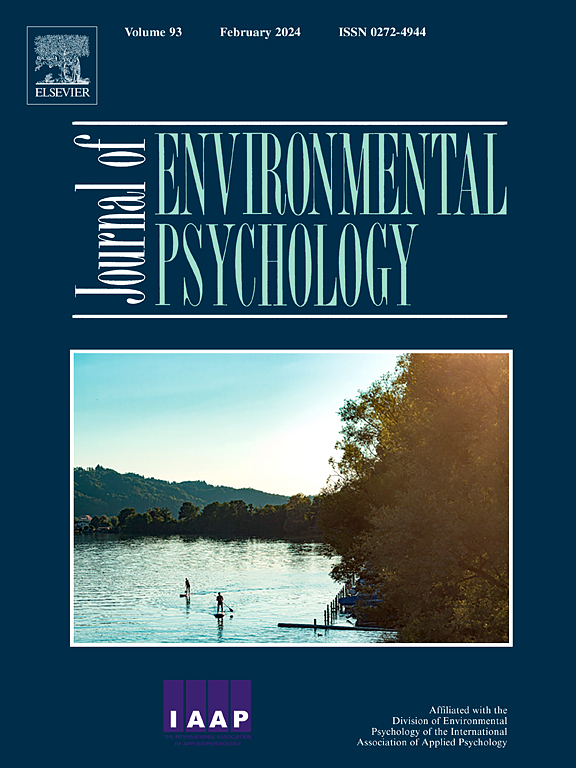可持续发展听起来像什么?制作反映环境和社会可持续性维度的音景
IF 7
1区 心理学
Q1 ENVIRONMENTAL STUDIES
引用次数: 0
摘要
本文介绍了一系列关于音乐和音景如何传达可持续性的抽象和多维概念的研究。一项试点研究确定了与可持续性相关的具体感官和情感描述符(例如,自然的,负责任的),然后使用这些描述符来确定能够传达这些描述符的心理声学特性(例如,音高,和声)。基于这些特性,我们选择了10个器乐配乐,并对它们唤起可持续发展联想的能力进行了评估。原声带经过调整,以反映环境(覆盖丛林、森林或海滩的声音;研究1)和社会(覆盖谈话、笑声或欢呼的声音;研究2)的维度。结果(综合N = 517)表明,与可持续性描述符一致的音轨可靠地引发了对可持续性的强烈感知。此外,叠加自然声音增强了与环境可持续性的联系,而融合人类群体声音则增加了与社会可持续性的联系。这些发现证明了音乐和音景在传达抽象概念方面的潜力,强调了将音乐元素与明确的声音结合起来以唤起有针对性的可持续性感知的重要性。利用这样的声景可以为组织提供新的途径来传达可持续性,在品牌和产品体验设计中具有潜在的应用。本文章由计算机程序翻译,如有差异,请以英文原文为准。

What does sustainability sound like? Crafting soundscapes that reflect environmental and social sustainability dimensions
This paper presents a series of studies examining how music and soundscapes can convey the abstract and multidimensional concept of sustainability. A pilot study identified concrete sensory and affective descriptors linked to sustainability (e.g., natural, responsible), which were then used to determine psychoacoustic properties (e.g., pitch, consonance) capable of communicating these descriptors. Based on these properties, ten instrumental musical soundtracks were selected and evaluated for their capacity to evoke sustainability associations. The soundtracks were adapted to reflect environmental (overlaying jungle, forest, or beach sounds; Study 1) and social (overlaying talking, laughing, or cheering sounds; Study 2) dimensions. Results (combined N = 517) indicated that soundtracks aligned with sustainability descriptors reliably elicited strong perceptions of sustainability. Additionally, overlaying nature sounds enhanced associations with environmental sustainability, while incorporating human group sounds increased social sustainability associations. These findings demonstrate the potential of music and soundscapes to communicate abstract concepts, highlighting the importance of integrating musical elements with explicit sounds to evoke targeted sustainability perceptions. Harnessing such soundscapes may offer new avenues for organizations to communicate sustainability, with potential applications in brand and product experiential design.
求助全文
通过发布文献求助,成功后即可免费获取论文全文。
去求助
来源期刊

Journal of Environmental Psychology
Multiple-
CiteScore
10.60
自引率
8.70%
发文量
140
审稿时长
62 days
期刊介绍:
The Journal of Environmental Psychology is the premier journal in the field, serving individuals in a wide range of disciplines who have an interest in the scientific study of the transactions and interrelationships between people and their surroundings (including built, social, natural and virtual environments, the use and abuse of nature and natural resources, and sustainability-related behavior). The journal publishes internationally contributed empirical studies and reviews of research on these topics that advance new insights. As an important forum for the field, the journal publishes some of the most influential papers in the discipline that reflect the scientific development of environmental psychology. Contributions on theoretical, methodological, and practical aspects of all human-environment interactions are welcome, along with innovative or interdisciplinary approaches that have a psychological emphasis. Research areas include: •Psychological and behavioral aspects of people and nature •Cognitive mapping, spatial cognition and wayfinding •Ecological consequences of human actions •Theories of place, place attachment, and place identity •Environmental risks and hazards: perception, behavior, and management •Perception and evaluation of buildings and natural landscapes •Effects of physical and natural settings on human cognition and health •Theories of proenvironmental behavior, norms, attitudes, and personality •Psychology of sustainability and climate change •Psychological aspects of resource management and crises •Social use of space: crowding, privacy, territoriality, personal space •Design of, and experiences related to, the physical aspects of workplaces, schools, residences, public buildings and public space
 求助内容:
求助内容: 应助结果提醒方式:
应助结果提醒方式:


